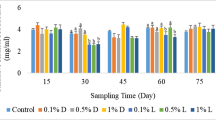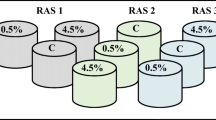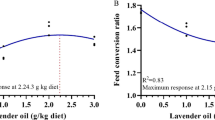Abstract
Epigallocatechin-3-gallate (EGCG), a very potent antioxidant derived from green tea, was compared with vitamin E in terms of its effects on antioxidant defense and immune response of rainbow trout, by means of a feeding trial of eight weeks. Two of the experimental diets were supplemented with EGCG at either 20 or 100 mg kg−1 diet (which contained only 30% of the intended levels) and the third was provided with 100 mg kg−1 vitamin E but not EGCG. The control diet was not supplemented with the test components. Observation of tissue levels indicated that the high amount of EGCG helped to increase the availability of the lipid-soluble antioxidant vitamin E. The lower levels of lipid hydroperoxide in the liver of fish fed the higher amount of EGCG suggested that it was an effective antioxidant. Considering the immune indices, EGCG and vitamin E at 100 mg (actual amounts 31.9 and 94.1 mg kg−1 diet, respectively) had identical capabilities in improving phagocytic activity and controlling hydrogen peroxide production by leucocytes. However, EGCG could possibly be more effective at enhancing serum lysozyme activity and the alternative complement activity. This work revealed the potential of EGCG as an antioxidant and an immunostimulant for rainbow trout, at least at the inclusion level of 32 mg kg−1 diet.




Similar content being viewed by others
References
Aldini G, Yeum K-J, Carini M, Krinsky NI, Russell RM (2003) (−)-Epigallocatechin-(3)-gallate prevents oxidative damage in both the aqueous and lipid compartments of human plasma. Biochem Biophys Res Commun 302:409–414
Álvarez E, Leiro J, Orallo F (2002) Effect of (−)-epigallocatechin-3-gallate on respiratory burst of rat macrophages. Int J Immunopharmacol 2:849–855
Byun DS, Kwon MN, Hong JH, Jeong DY (1994) Effects of flavonoids and α-tocopherol on the oxidation of n-3 polyunsaturated fatty acids. 2. Antioxidizing effect of catechin and α-tocopherol in rat with chemically induced lipid peroxidation. Bull Korean Fish Soc 27:166–172
Cho S, Lee S-M, Park B, Ji S-C, Lee J, Bae J, Oh S-Y (2007) Effect of dietary inclusion of various sources of green tea on growth, body composition and blood chemistry of the juvenile olive flounder, Paralichthys olivaceus. Fish Physiol Biochem 33:49–57
Chung S, Secombes CJ (1988) Analysis of events occurring within teleost macrophages during the respiratory burst. Comp Biochem Physiol B 89:539–544
Crouvezier S, Powell B, Keir D, Yaqoob P (2001) The effects of phenolic components of tea on the production of pro-and anti-inflammatory cytokines by human leukocytes in vitro. Cytokine 13:280–286
Higdon JV, Frei B (2003) Tea catechins and polyphenols: health effects, metabolism, and antioxidant functions. Crit Rev Food Sci 43:89–143
Ikeda I, Imasato Y, Sasaki E, Nakayama M, Nagao H, Takeo T, Yayabe F, Sugano M (1992) Tea catechins decrease micellar solubility and intestinal absorption of cholesterol in rats. Biochim Biophys Acta 1127:141–146
Ishihara N, Araki T, Tamaru Y, Inoue M, Nishimura A, Aoi N, Chu DC, Juneja LR, Morishita T (2002) Influence of green tea polyphenols on feed performance, growth performance, and fish body component in yellowtail (Seriola quinqueradiata). Jpn J Food Chem 9:7–14
Kaneko T, Baba N, Matsuo M (2001) Structure-activity relationship of antioxidants for inhibitors of linoleic acid hydroperoxide-induced toxicity in cultured human umbilical vein endothelial cells. Cytotechnology 35:43–55
Kashima M (1999) Effects of catechins on superoxide and hydroxyl radical. Chem Pharm Bull 47:279–283
Kono M, Furukawa K, Sagesaka YM, Nakagawa K, Fujimoto K (2000) Effect of green tea extracts and green tea grounds as dietary supplements on cultured yellowtail and ayu. Nippon Shokuhin Kagaku Kaishi 47:932–937
Leiro J, Arranz JA, Paramá A, Álvarez MF, Sanmartín ML (2004) In vitro effects of the polyphenols resveratrol, mangiferin and (−)-epigallocatechin-3-gallate on the scuticociliate fish pathogen Philasterides dicentrarchi. Dis Aquat Org 59:171–174
López-Varela S, Sánchez-Muniz FJ, Cuesta C (1995) Decreased food efficiency ratio, growth retardation and changes in liver fatty acid composition in rats consuming thermally oxidized and polymerized sunflower oil used for frying. Food Chem Toxicol 33:181–185
Lotito SB, Fraga CG (1998) (+)-Catechin prevents human plasma oxidation. Free Radic Bio Med 24:435–441
Lotito SB, Fraga CG (2000) Catechins delay lipid oxidation and α-tocopherol and β-carotene depletion following ascorbate depletion in human plasma. P Soc Exp Biol Med 225:32–38
Ma L-P, Liu Z-Q, Zhou B, Yang L, Liu Z-L (2000) Inhibition of free radical induced oxidative hemolysis of red blood cells by green tea polyphenols. Chinese Sci Bull 45:2052–2056
Matsunaga K, Klein TW, Friedman H, Yamamoto Y (2002) Epigallocatechin gallate, a potential immunomodulatory agent of tea components, diminishes cigarette smoke condensate-induced suppression of anti-Legionella pneumophila activity and cytokine responses of alveolar macrophages. Clin Diagn Lab Immun 9:864–871
Meng Q, Velalar CN, Ruan R (2008) Effects of epigallocatechin-3-gallate on mitochondrial integrity and antioxidative enzyme activity in the aging process of human fibroblast. Free Radic Bio Med 44:1032–1041
Mukai K, Mitani S, Ohara K, Nagaoka S-I (2005) Structure-activity relationship of the tocopherol-regeneration reaction by catechins. Free Radic Bio Med 38:1243–1256
Murakami C, Hirakawa Y, Inui H, Nakano Y, Yoshida H (2002) Effect of tea catechins on cellular lipid peroxidation and cytotoxicity in HepG2 cells. Biosci Biotech Biochem 66:1559–1562
Nakagawa H, Mustafa MDGH, Takii K, Umino T, Kumai H (2000) Effect of dietary catechin and Spirulina on vitamin C metabolism in red sea bream. Fish Sci 66:321–326
Ortuño J, Esteban MA, Meseguer J (2000) Kinetics of hydrogen peroxide production during in vitro respiratory burst of seabream (Sparus aurata L.) head-kidney leucocytes, as measured by a flow cytometric method. Fish Shellfish Immunol 10:725–729
Puangkaew J, Kiron V, Somamoto T, Okamoto N, Satoh S, Takeuchi T, Watanabe T (2004) Nonspecific immune response of rainbow trout (Oncorhynchus mykiss Walbaum) in relation to different status of vitamin E and highly unsaturated fatty acids. Fish Shellfish Immunol 16:25–39
Raederstorff DG, Schlachter MF, Elste V, Weber P (2003) Effect of EGCG on lipid absorption and plasma lipid levels in rats. J Nutr Biochem 14:326–332
Rice-Evans CA, Miller NJ, Bolwell PG, Bramley PM, Pridham JB (1995) The relative antioxidant activities of plant-derived polyphenolic flavonoids. Free Radical Res 22:375–383
Shrestha S, Ehlers SJ, Lee J-Y, Fernandez M-L, Koo SI (2009) Dietary green tea extract lowers plasma and hepatic triglycerides and decreases the expression of sterol regulatory element-binding protein-1c mRNA and its responsive genes in fructose-fed, ovariectomized rats. J Nutr 139:640–645
Thuvander A, Norrgren L, Fossum C (1987) Phagocytic cells in blood from rainbow trout, Salmo gairdneri (Richardson), characterized by flow cytometry and electron microscopy. J Fish Biol 31:197–208
Trotter J (1998) WinMDI (Windows multiple document interface for flow cytometry). Version 2.8 http//www.facs.Scripps.edu/software.html
Zhou B, Wu L-M, Yang L, Liu Z-L (2005) Evidence for α-tocopherol regeneration reaction of green tea polyphenols in SDS micelles. Free Radic Bio Med 38:78–84
Acknowledgments
This work was undertaken as part of the doctoral research of Jumroensri Puangkaew (Thawonsuwan) at the Tokyo University of Marine Science and Technology, (TUMSAT). Co-authors VK and AP were also associated with TUMSAT when the study was undertaken. The authors would like to thank the Fuji Trout Hatchery of Shizuoka Prefecture Fisheries Experiment Station, Shizuoka, Japan, for providing the fish. The initiative of Mr Saitoh Taro of DSM Nutritional Products, Japan, is gratefully appreciated. This work was partially funded by the Japanese Ministry of Education, Culture, Sports, Science, and Technology (MEXT).
Author information
Authors and Affiliations
Corresponding author
Rights and permissions
About this article
Cite this article
Thawonsuwan, J., Kiron, V., Satoh, S. et al. Epigallocatechin-3-gallate (EGCG) affects the antioxidant and immune defense of the rainbow trout, Oncorhynchus mykiss . Fish Physiol Biochem 36, 687–697 (2010). https://doi.org/10.1007/s10695-009-9344-4
Received:
Accepted:
Published:
Issue Date:
DOI: https://doi.org/10.1007/s10695-009-9344-4




